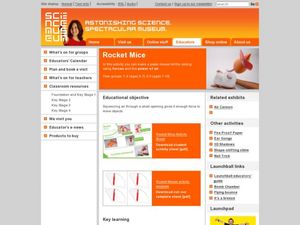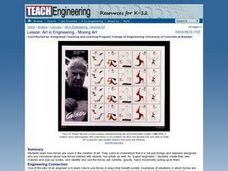Curated OER
The Pressure's Off II - Flight
Learners investigate what allows air plane to fly, why birds can fly and why people can't. They construct a giant hot air balloon that can be launched using only a hair dryer.
Curated OER
How to Make Water Run Uphill
Students observe science demonstration. In this science lesson, students watch an experiment showing water moving up from an area of higher concentration to an area of lower concentration, due to a change in atmospheric pressure.
Curated OER
Weather Watchers
Students study basic meteorology concepts. They build a simple barometer to measure air pressure. They explore the concepts of relative humidity, air convection currents and temperature inversions and to discover their connection to...
Curated OER
Why Your Ears Pop
In this ears worksheet, students read about what causes your ears to pop when you change altitude and about equalizing air pressure. Then students complete 3 short answer questions.
Curated OER
This Lesson Is a Breeze, So Don't Blow It!
Students conduct an experiment to show that air is all around us and that wind is the movement of air. They construct a weather vane to determine which direction the wind is blowing.
Curated OER
Catch a Dream
Students apply the concepts of air pressure, the Bernoulli Effect, and angle of attack to build their own model planes out of paper, plastic, wooden rods, and drinking straws.
Curated OER
Earth's Atmosphere
In this Earth's atmosphere activity, students observe the effects of air pressure using an egg. They describe what happens to the egg and what makes it do what it does. Then they determine how to get the egg out of the bottle opening at...
Curated OER
Rocket Mice
Students explore air. In this air lesson, students create a paper mouse and observe how the force of air can move objects.
Curated OER
The Air Out There
Students build windmills and weather vanes. In this lesson on air, students build wind vanes and windmills to demonstrate that air moves. Students determine the direction of air movement and measure the speed at which it is moving.
Curated OER
How Air Moves In and Out of the Lung
Students gain an understanding of the respiratory system. In this biology lesson plan, students demonstrate how air enters and leaves the lungs, and explore the relationship between breathing rate and exercise.
Curated OER
Sunlight and Warm Air
Students discuss radiant energy from the sun, performing a simple experiment with sun glasses and bright light to demonstrate the concept. Students further participate in simple in-class experiments to demonstrate: air density as it...
Curated OER
Movement of Air
In this movement of air worksheet, students identify and describe the purpose for convection and how it effects Earth. Then they describe what thermals are and why they occur in hot and cold air movements. Students also explain why...
Curated OER
Art in Engineering - Moving Art
Learners study how forces are applied in the creation of art. They design mobiles and pop-up books while identifying which forces of nature act upon them. They look at air currents, gravity, and hand movement.
Curated OER
Junkyard Wars: Air Movers
Students study Rube Goldberg machines. In this investigative lesson students design and build a machine that uses several steps to move an aluminum can.
Curated OER
Warm and Cold Air
Students examine what happens to air when it is heated or cooled. They conduct an experiment using bottles and balloons, record and discuss their observations, and write a hypothesis.
Curated OER
Principles of Flight: Bernoulli's Lift
Students discover how air pressure effects flight. In this physics lesson, students create two types of airplane wings so they can observe the way air pressure creates lift. Students utilize a printout to create the airplane wings.
Curated OER
Convection and Wind
Learners use water, beakers, hot plates, paper dots, and goggles to participate in a hands on activity where they see how a convection current creates wind. In this convection current lesson plan, students participate in a hands on...
Curated OER
Do Some Research: Air Science 1
In this universe research activity, students read the sentence and then use a library or the Internet to find the answer and write it on the blue line. Students then write a short report about this topic: a violent whirlwind in which the...
Curated OER
Fantasy Allegory of Air
Students analyze the painting Jan Brueghel and design their own book. In this art and book lesson, students discuss the elements of fantasy from the painting and create their own book. Students illustrate the book and create a painting...
Curated OER
Moist Air & Clouds
Fifth graders study the weather and water cycle of clouds. In this water cycle lesson, 5th graders read background information about evaporation, condensation, and the states of water.
Curated OER
Water Changes and Moves
Pupils explore the three forms of water and observe how it changes from a solid to a liquid to a gas. The concepts of condensation, evaporation and the introduction to the water cycle form the basis of this lesson plan.
Curated OER
Up in the Air
Students evaluate the impact of volcanic ash on the surroundin environment. Through discussion, videos and activities, they identify the various ways in which volcanic ash can be more detrimental than volcanic magma and lava.
Curated OER
Terminal Velocity
Students calculate acceleration due to gravity with the measurements of the period of a pendulum or measurements of the time for an object to fall from different heights. They observe and measure the effect of air resistance on the...
Rochester Institute of Technology
Biomechanical Joint
Discuss mechanical advantage and how the human body moves/works. Learners focus on bioengineering, working together to build a functioning mechanical arm. Additionally, they analyze an air muscle, discussing its appropriate use in humans.
Other popular searches
- Weather Moving Air
- Wind as Moving Air
- Wind Is Moving Air
- Moving Air Music
- Moving Air Devices
- Ind as Moving Air
- Moving Air on Soil
- Moving Air Crossword
- +Wind as Moving Air
- Hot Air Moving Spirals

























